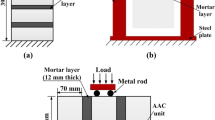Abstract
Traditional unstabilized adobe low-rise buildings are common in many Chinese small towns and villages. This paper presents a study on the uniaxial compressive strength and stress–strain behavior of traditional unstabilized adobe blocks and masonry prisms with various compositions. The adobe blocks were manually produced by Chinese traditional technique in various proportions of natural soil and sand. The influence of various proportions on unconfined compressive strength, dry density and initial tangent modulus are discussed. Following this, soil mortars in three different proportions were used to construct adobe masonry prisms, with the purposes of understanding the influence of mortar strength to block strength ratio on compressive strength and stress–strain characteristics. The result shows that the compressive strength, initial tangent modulus and Poisson’s ratio of prism are influenced by the ratio of mortar strength to block strength. In addition, tangent modulus and Poisson’s ratio increase with the ratio of stress to peak strength. It was also found that although coefficients of variation of experimental results are reduced by load–unload cycles, peak strains are largely increased.






Similar content being viewed by others
References
Binici H, Aksogan O, Shah T (2005) Investigation of fibre reinforced mud brick as a building material. Constr Build Mater 19:313–318
Hendry AW (1981) Structural brickwork. Macmillan, London
Hendry AW (1990) Structural masonry. Macmillan, London
Jayasinghe C, Mallawaarachchi RS (2009) Flexural strength of compressed stabilized earth masonry materials. Mater Des 30:3859–3868
Kouakou CH, Morel JC (2009) Strength and elasto-plastic properties of non-industrial building materials manufactured with clay as a natural binder. Appl Clay Sci 44:27–34
McNary WS, Abrams DP (1985) Mechanics of masonry in compression. J Struct Eng 111(4):857–870
Mesbah A, Morel JC, Walker P, Ghavami Kh (2004) Development of a direct tensile test for compacted earth blocks reinforced with natural fibers. J Mater Civ Eng 16(1):95–98
Morel JC, Pkla A, Walker P (2007) Compressive strength testing of compressed earth blocks. Constr Build Mater 21:303–309
Nogwi BA (1997) Improving the traditional earth construction: a case study of Botswana. Constr Build Mater 11:1–7
Piattoni Q, Quagliarini E, Lenci S (2011) Experimental analysis and modelling of the mechanical behavior of earthen bricks. Constr Build Mater 25:2067–2075
Reddy VBV, Gupta A (2006) Strength and elastic properties of stabilized mud block masonry using cement-soil mortars. J Mater Civ Eng 16(5):472–476
Reddy VBV, Vyas UChV (2008) Influence of shear bond strength on compressive strength and stress–strain characteristics of masonry. Mater Struct 41:1697–1712
Reddy VBV, Richardson Lal, Nanjunda Rao KS (2009) Influence of joint thickness and mortar-block elastic properties on the strength and stresses developed in soil-cement block masonry. J Mater Civ Eng 21(10):535–542
Savastano H Jr, Warden PG, Coutts RSP (2000) Brazilian waste fibers as reinforcement for cement-based composites. Cem Concr Compos 22:379–384
Vega P, Juan A, Guerra M (2011) Mechanical characterisation of traditional adobes from the north of Spain. Constr Build Mater 25:3020–3023
Walker P (1995) Strength, durability and shrinkage characteristics of cement stabilized soil blocks. Cem Concr Compos 17(4):301–310
Walker P (1999) Bond characteristics of earth block masonry. J Mater Civ Eng 11(3):249–256
Walker P (2004) Strength and erosion characteristics of earth blocks and earth block masonry. J Mater Civ Eng 16(5):497–506
Yetgin S, Cavdar O, Cavdar A (2008) The effects of fiber contents on the mechanical properties of the adobes. Constr Build Mater 22:222–227
Acknowledgments
This research work was supported by the Science Fund for Creative Research Groups of the National Natural Science Foundation of China (Grant No. 51121005).
Author information
Authors and Affiliations
Corresponding author
Rights and permissions
About this article
Cite this article
Wu, F., Li, G., Li, HN. et al. Strength and stress–strain characteristics of traditional adobe block and masonry. Mater Struct 46, 1449–1457 (2013). https://doi.org/10.1617/s11527-012-9987-y
Received:
Accepted:
Published:
Issue Date:
DOI: https://doi.org/10.1617/s11527-012-9987-y




